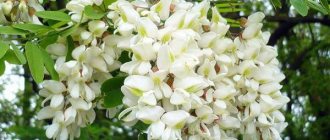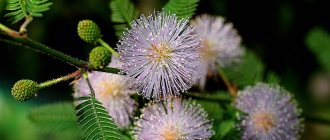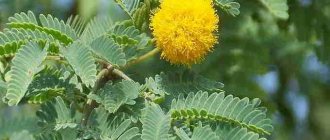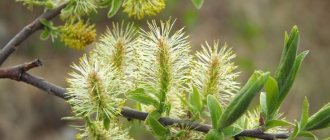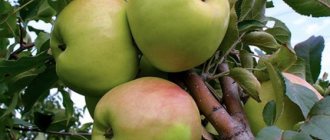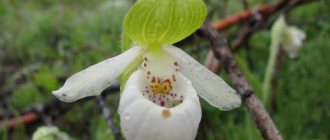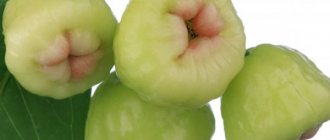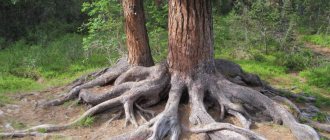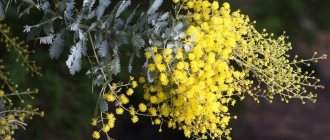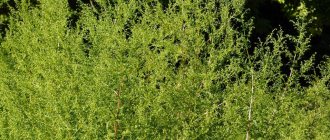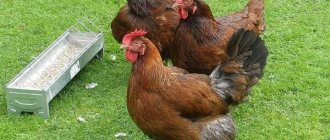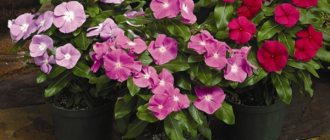Botanical description
White locust has a spreading crown, and the bark is dark, thick and deeply furrowed. The tree has a very powerful root system.
The roots can penetrate to a depth of more than 20 meters. With very good soil, the roots can grow into the ground to great depths. The imparipinnate leaves consist of 4-8 soft, light green, elliptical leaflets. They are located on short petioles. The modified leaves, called spines, have a very sharp end. These crescent-shaped thorns are woody and strong, and look very elegant.
Acacia blooms with large, white, numerous flowers with a bright aroma that hang on the racemes. Its fruit is a flat bean 10 cm long, containing dark seeds. The tree lives for more than 50 years.
White acacia is characterized by rapid growth, especially in the first 10 years. If conditions are favorable, it can grow up to 30 meters.
The tree is distinguished by the following qualities:
- endurance;
- drought resistance;
- love for the sun.
Robinia description and history
The species is represented by about twenty species and is distributed throughout Central and North America.
- The colonization of Europe by Pseudoacacia Robinia plants occurred in 1601. Gardener Jean Robin, traveling around North America, collected the seeds and gave them to his son Vespasian Robin, who planted them in the Parisian Medical Garden.
- There is a version that the seeds were collected in Virginia.
The tree received the name “Robinia” from the Swedish botanist Carl Linnaeus in honor of the Roben family, and was popular first as the first Robinia of Europe, and then as the oldest tree of Paris.
By 1895, the girth of the tree trunk was just over 5 m.
For your information. The seeds of this tree are believed to be the progenitor of all Acacia-Robinia plants in Europe.
Robinia has a number of factors contributing to its active introduction - these are genetic and phenotypic modification.
View:
- A deciduous tree with a trunk thickness of 30-40 cm , the height does not reach 30 meters , with a wide, wide crown, representing separate tiers.
- At the beginning of growth, the bark is light brown and has elongated, longitudinal cracks and becomes dark gray with age.
- The color of the shoots is greenish-gray or reddish-brown.
- Robinia has a serious root system that goes 10-12 meters underground . This allows the tree to remain wind-resistant.
- The leaves have different colors depending on the time of year : in the spring they are green, gradually begin to darken and by autumn they become dark green, sometimes even yellow.
Flowering and fruits
Robinia flowers are elastic, drooping racemes of white color, from 10 to 20 cm long. During the pollination period, elongated, flattened, narrow-winged, cracking bean fruits about 8 cm appear on the tree.
The growing season of Robinia begins in the first days of May, flowering until mid-June, fruits appear by the end of September , and with the arrival of October, the leaves of the tree begin to fall.
Frost resistance
Young plants are particularly sensitive to temperatures close to zero. Frost resistance develops with age , although even at lower temperatures there is a possibility of damage to the level of snow cover.
The ability for high shoot formation allows the white acacia Robinia to quickly regenerate, while the rhizome is preserved.
Lignification of shoots reaches 100%.
The leaves do not fall off until severe frosts and almost do not change color.
In winter, pseudoacacia Robinia adds aesthetics to its numerous beans , which remain on the tree until spring.
Conditions for growth
Robinia is a decoration of many gardens due to its unpretentiousness, as well as the characteristics of its crown and fragrant colorful flowers.
The first decade for a Robinia plant is characterized by a high growth rate, with pruning of shoots and proper care.
- It is unpretentious to low soil fertility and aridity , but does not like damp soils at sub-zero temperatures, loves light, and is drought-resistant.
- When planted tightly, its crown goes up.
- Can be considered one of the smoke and gas resistant plants with a spreading root system .
In good years it blooms abundantly every year, while many shrubs and trees are already fading.
It is valuable both in group and single plantings; it has a number of decorative forms that are propagated by grafting.
Loves dry, almost stony soil.
For your information. In the Moscow region, pseudoacacia can be found in the landscaping of the southern cities of the region; it is also found along the banks of the Oka River in wild parks and settlements. Robinia adapts well to the urban conditions of Moscow. Can be found as a shrub in city parks and gardens.
Applications of Robinia pseudoacacia
Bacteria live on the root system of Robinia, which fix atmospheric nitrogen, so planting it helps improve the quality of the soil.
- The French and Germans grew Robinia to support wine grapes.
- Due to their shoot-forming ability, robins are found as clipped living fences.
- This plant breed is wind-resistant, therefore. widely used as a wind wall.
- The root system enriched with nitrogen is an excellent feed for animals .
- Robinia is considered to be a plant for producing honey . Clusters of delicately scented flowers contain a huge amount of nectar.
Interesting. It is known that about 500 kg of honey can be collected from one hectare of Robinia. Honey can even be confused with regular water due to its consistency. But this “water” has the sweet, intoxicating scent of honey, which is what honey from white acacia has.
- Thanks to its ability to be easily polished, durability, beauty, and color, Robinia wood is valued in furniture production.
Photo
In the photo you can see what acacia looks like with flowers of different shades.
Medicinal properties and contraindications
The plant is endowed with a number of medicinal properties, namely:
- anti-inflammatory;
- astringent;
- antipyretic;
- hemostatic;
- expectorant;
- diuretic.
Black locust helps reduce the amount of nitrogen in the blood. However, we must remember that the alkaloid toxalbuminrobin contained in wood and bark irritates and thereby destroys the protective mucous membranes.
Preparations containing this plant must be taken in limited doses, otherwise poisoning with toxic substances may occur.
It is prohibited to take products based on acacia flowers if:
- low stomach acidity;
- individual intolerance;
- low blood pressure;
- pregnancy and lactation.
Use of white acacia by man
White acacia honey has long been known for its delicate taste, pleasant aroma, and healing properties. In addition to collecting it, a person prepares medicinal raw materials in the form of bark and flowers of the plant. Raw materials intended for medicinal purposes are prepared at the beginning of the summer season. The procurement rules are as follows:
- it is necessary to cut off the acacia inflorescences entirely, separating each flower from the base after the harvesting process;
- take exclusively the bark of young tree branches;
- To dry, spread in a thin layer;
- dry in places where direct sunlight cannot penetrate and that are well ventilated.
It is important! When preparing medicinal raw materials, you should do everything carefully. The tree has many thorns, which can easily cause injury. It is better to carry out the harvesting process wearing long sleeves and gloves.
White acacia is used in medicine as an effective remedy that has the following range of actions:
- antispasmodic;
- antipyretic;
- anti-inflammatory;
- expectorant;
- antispasmodic;
- mild laxative;
- hemostatic.
In folk medicine it is used to prepare infusions and tinctures. These remedies help against colds, stomach pain, kidney stones, cystitis, and rheumatism. For infusions and tinctures, the amount of raw materials used is within the following limits:
- For a glass of boiling water, add a tablespoon of flowers or half a teaspoon of bark.
- For one part of white acacia flowers, two parts of 70% alcohol.
There is no need to add additional components to the products. Infusions should be ready for use an hour after preparation, and alcohol tinctures after 10 days.
Pay attention! Alcohol tincture of the plant is used for external use, and water infusions for internal use. When using products prepared from tree bark, you should follow strict dosages.
The medicinal properties of white acacia have the opportunity to manifest themselves due to the wide qualitative composition of the plant. The main substances that include the composition of flowers and tree bark are:
- flavonoids;
- organic acids;
- tannins;
- phytosterol;
- glycoside;
- essential oil;
- stigmasterol.
The qualitative composition of medicinal raw materials depends on the conditions in which the tree grew, the period of assembly of this medicinal raw material, and the specific method of drying and storing it. Dried white acacia flowers retain their beneficial substances for no more than a year, and the bark is suitable for use for three years.
Description of the parts of the tree
White acacia seeds are presented in the form of a bean, which can be:
- elongated;
- ovoid;
- lanceolate;
- linear.
The bob can be curved or straight. The fruits of this plant are flattened pods, mostly brown in color. There are 5-6 pieces of bean seeds inside them. Inflorescences are paniculate, cylindrical and capitate in shape.
The spines of many acacia species are a kind of modified stipules. As for flowers collected in hanging clusters, there are a large number of them. They are large or small, bisexual and heterosexual.
Sub-varieties
The most common subvarieties of Robinia include sticky, New Mexican, yellow, fragrant white, and bristle-haired.
New Mexican
New Mexican acacia grows no more than 12 m. Its soft pink flowers have no odor.
Sticky
Sticky acacia has a rounded crown. It blooms with pink and purple flowers. The tree is so called because it has sticky hairs on:
- shoots;
- inflorescences;
- leaves.
Yellow
Yellow locust, called cargana, is a multi-stemmed shrub. It grows up to 3 meters in height. Its bark is gray-green, and its flowers are also yellow. Previously, this yellow acacia was popularly called the pea tree.
With pink flowers
There is also another shrubby form of acacia with pink flowers. It is distinguished by reddish bristles covering the entire plant.
Description of the plant
White acacia belongs to the legume family. Another name for this plant is Robinia false acacia. It is the closest relative of the true acacia, but belongs to a different genus.
This acacia can grow up to 18-25 m, sometimes even more. It grows quickly, reaching a height of 5 m already at the age of three. The crown is openwork, spreading. The leaves are bright green, large, odd-pinnate. They bloom towards the end of May. In places where the stipules are located there are spines. The fragrant white flowers look like moths. They are collected in drooping inflorescences, the length of which is 10-25 cm. Flowering begins at the end of spring. And during this period, white acacia is most attractive.
Acacia is a good honey plant. The tree attracts many bees with its delicate aroma. After flowering ends, the plant produces beans, the seeds of which usually ripen by mid-autumn.
Bloom
Flowering occurs at the age of three or four years in May - June, the fruits ripen in September and weigh throughout the winter. A young plant needs to be looked after.
Care consists of the following regular actions:
- watering;
- feeding;
- removing dead branches;
- removing weeds.
The acacia tree needs to get a lot of sunlight; the young tree should not be allowed to be shaded by nearby growing trees. Young seedlings need to mulch the soil around them. Small pebbles or peat are suitable for this.
Important! To prevent the tree from weakening, immediately after it blooms, you need to remove all dried flowers.
It happens that white acacia does not bloom for a long time. The reason for this is groundwater, due to which the roots begin to rot. If the tree is young, only replanting or planting a new seedling in a normal place will help correct the situation.
Planting Robinia
The choice of location for planting a robinia seedling is determined by the plants’ need for light. Natural protection from the north wind is also desirable for pink robins.
All robins should be planted in the spring, before buds open. The fact is that during autumn planting, the soil is too cold for the growth of the roots of these heat-loving plants and too wet, which is why the roots damaged during digging immediately begin to rot. In no case should you plant robins too deep - all because of the same danger of damping off. The ideal soil quality is a combination of sand and compost with the obligatory addition of some alkaline substance - ash, dolomite flour, old slaked lime, crushed limestone.
In general, these plants thrive much better on poor but loose soils than on rich and clayey soils. When planting on a clay area, you can try, as when growing stone fruit crops, planting on a mound, when the surface of the tree trunk circle, after settling, is above the soil level.
Features of Robinia
- Life form - Tree.
- Size - Height 20-25 m, width 12-20 m, trunk diameter up to 1.2 m.
- Crown - Openwork rounded.
- Leaves - Unpaired, 20-30 cm long, light green, poisonous.
- Flowering - In May-June, the flowers are white, fragrant, collected in racemes 10-25 cm long.
- Fruits - Beans up to 12 cm.
- Growth characteristics - Annual growth from 20 cm to 1 m at a young age.
- Durability - Up to 100 years.
The plant contains Toxalbumin. The content in individual parts of the plant varies. Small doses can cause stomach upsets; large doses can be fatal.
Attitude:
- to the light - photophilous;
- to the soil - not demanding, but prefers light soils, tolerates salinity;
- for moisture - moderate watering;
- to the wind - not wind resistant;
- to temperature - frost-resistant.
Urban conditions - Smoke and gas resistant.
Decorative - Decorative during flowering.
Application - As a single tree, group plantings and alleys, it can strengthen soil on slopes.
Robinia pseudoacacia
Use in garden design
In addition to the fact that acacia is considered a useful planting, it is also an excellent ornamental tree for decorating the local area and garden plot. Owners of summer cottages use white acacia to create a nice hedge on their territory.
Designers often use this tree when landscaping gardens and parks. White locust grows quickly and is easy to shape. To do this, in the fall, young seedlings are planted in a checkerboard pattern at a distance of 25 cm from each other. In the future, it is necessary to trim them in time, not forgetting to periodically carry out this procedure. The result will be a beautiful green dense wall.
Disembarkation and care
White acacia is an unpretentious and fast-growing tree that will not cause any trouble, especially if planted correctly.
To do this, you will need to choose the right place - sunny, without a lot of moisture. The tree will not take root in swampy areas or in the shade; windy places are also not recommended: seedlings can be uprooted. It is best to plant trees in spring, May or early summer, when the soil is sufficiently warm. When planting in the fall, the plant will need additional protection; it is also necessary to choose the location carefully: if the acacia is in a cold or overly wet place, its roots may be damaged and begin to rot.
Before planting, you need to dig several deep holes at a distance of 2.5-3 meters from each other - the roots of Robinia develop well and occupy a significant area. The depth must be sufficient for the entire length of the tree, otherwise the taproot will not be able to develop normally.
At the bottom of the hole you need to pour a layer of small stones or crushed stone for drainage, then fill the rest of the area with a mixture of 3 parts turf, 2 parts sand and 2 parts compost. When planting, it is necessary to ensure that the root collar is not buried. Afterwards, the tree is watered abundantly and, if necessary, mulched with peat - this will help retain moisture and prevent the roots from freezing or overheating.
Gardener's advice: in the first ten years, the plant can add 80-120 cm per year - a decrease in growth rate may indicate the occurrence of certain problems or disease.
In the first year, white acacia requires abundant watering - this will help it take root and begin to grow.
Already next summer the tree will be able to survive only on rain. During June and July, it is necessary to regularly feed the seedlings with a solution of manure (part manure to 5 parts water) or bird droppings (part litter to 20 parts water). When Robinia grows and becomes strong enough, it will need regular complementary feeding with ready-made complex fertilizers.
Acacia does not like to have its roots disturbed, and therefore does not require loosening the soil. The same applies to pruning branches: you can remove shoots damaged by frost only after the robinia has flowered.
In the first three years for the winter, the trunk of the white acacia must be insulated with burlap or spruce paws, the roots are covered with dry leaves or peat.
It is important to note that acacia is practically not susceptible to diseases, but insect attacks can harm it. Its worst enemies are aphids, mealybugs and bagworms.
They can harm leaves and young shoots - the consequences of their attacks can be seen in the photo. To prevent this, you will need to regularly inspect the crown, cut off damaged branches and burn them. Trees should be treated with poisons after flowering, so as not to harm the bees and spoil the honey.
We also suggest you read about wild rosemary in the following article:
Tips for planting and care
- To plant a tree, you need to choose a place open to sunlight. You should not plant a tree in lowlands, because then the water will stagnate, and this will negatively affect its growth and development.
- Since acacia grows to enormous sizes over time, while it has a spreading crown, initially the place where it will grow must be spacious.
- The tree feels good on any soil, although it prefers the soil to be light. A good soil for it is considered to be a mixture of compost and sand with the addition of one of the following components:
- crushed limestone;
- dolomite flour;
- long slaked lime;
- ash.
- The tree is not afraid of drought and wind. White acacia is planted in a shallow hole into which a drainage layer is poured. To secure the young seedling, you need to drive a stake there, attach it to it. After this, do not forget to water the tree.
- When buying an acacia seedling, you must inspect it. The trunk should be:
- small;
- not very thin;
- with beautiful branching.
- The root system is considered good if it:
- well developed;
- compact;
- dense.
- Often the tree is sold in a container. You need to make sure that it is grown there and not planted before selling.
Attention! It must be borne in mind that you should not delay planting in the fall, because the soil becomes wetter and colder. As a result, there is a danger of root rotting.If the roots of the acacia tree peek through the holes in the bottom, then the seedling has been growing in it from the very beginning. Such plants can be planted at any time.
The best time to plant seedlings whose roots are exposed, this applies to those not grown in containers, is considered to be spring. This procedure should be done before the buds begin to bloom or after the heat subsides - late summer or early autumn. The hole for the seedling needs to be dug according to the size of the root and slightly deeper than its length.
- Sometimes white acacia is propagated by seeds. When buying them, be sure to look at the date. The germination period of seeds is limited to three years. Before planting, they must be soaked in water for a day in advance, then placed in the grooves, but not deep. The procedure is carried out in autumn or spring.
- The most optimal temperature for good growth of white acacia is considered to be +20…+25 °C. The highest temperature is +40°C. In winter, the plant can withstand -35 °C; lower temperatures have a negative effect on it. It may not survive such cold weather.
- Young plants need to be watered regularly; adults need additional watering during the driest period. The rest of the time, natural moisture in the form of precipitation is sufficient.
- White acacia requires fertilizer only 3 years after planting. Any complex fertilizer is suitable for this. At the beginning of spring and flowering, it is useful to feed with organic compounds.
- This tree should only be pruned if necessary. In the summer, branches that are frozen or broken are cut off. In the spring, you can try to make a mold from the crown, although after this procedure the white acacia grows long shoots. The tree is replanted in early autumn or spring. Then there is a high probability that it will take root well.
- With proper planting and proper care, this fast-growing tree will grow every year by 60-80 cm in height and 20-30 cm in width. It easily tolerates bad weather conditions.
Important! It must be borne in mind that white acacia does not respond well to digging up the trunk circle, so the earth around the trunk is only slightly loosened. There is no need to plant plants, especially bulbous ones, in this place.
Caring for white acacia
Although Robinia is not a whimsical representative of the plant world, timely care will prolong the joy of contemplating this beautiful plant. The following tips will help you care for her properly.
- Be prepared to maintain a warm and humid microclimate.
- Protect your seedling from proximity to weed plants. Those with long roots are especially dangerous.
- Do not plant flowers that need deep tillage next to acacia.
- The first few years after planting, insulate the seedlings during the winter. Peat or dry leaves are suitable for this purpose. Covering layer – 10 cm.
- 3 years after planting, start feeding the tree with complex mineral fertilizers.
- Don't trim unnecessarily! Branches frozen in winter are removed after flowering.
In the first years of life, the seedling gains about a meter in height every year. Then the pace slows down a little. White acacia lives up to 50 years.
Types of reproduction
White acacia reproduces:
- basal shoots - shoots;
- seeds;
- cuttings;
- layering.
Cuttings
The simplest way is propagation by cuttings - shoot tips:
Acacia cuttings for propagation are cut at an angle. The length of these cuttings should be at least 10 cm. For better rooting, the shoots are placed in a special solution of “Zircon” or “Epin” for 6 hours.
- Then prepare nutritious soil from:
- 1 part ready-made mixture for flowering plants;
0.5 parts vermiculite;
- 1 part sand;
- some charcoal.
- Before planting the cuttings, you need to water the soil, then deepen it and cover it with a plastic bottle. Place the box in a warm, well-lit place where the temperature does not drop below 22 °C.
- Rooting will take 2-3 months, and in order for the process to go faster, heating must be provided from below.
One of the main conditions for the favorable growth of young acacia is the presence of a nutrient substrate.
By layering
In spring, white acacia can be propagated by layering:
- This procedure requires a young shoot (no older than 2 years), which grows closer to the surface. Dig a shallow groove under it and place it in it. Make several cuts on its underside in advance.
- To prevent the shoot from straightening, it is clamped with staples made of wire.
- Then they dig in and water.
- The following spring, this seedling is separated from the tree and immediately planted in the place where it will grow.
By shoots
Propagation of acacia by separating the root shoots that mature plants form is also carried out in the spring. Carefully dig up the root system of the mother tree and cut off the root shoots, always along with a lump of earth. They are immediately planted in a permanent place and watered. When planting several trees, the distance between them should be at least 50 cm.
Seeds
Can be propagated by seeds - beans. They ripen at the end of November. At this time, they are collected, wrapped in paper and stored in the refrigerator until spring. In the greenhouse in the spring they are sown in loose soil. The distance between them should be 20 cm.
In order for acacia seeds to germinate, a temperature of 22-25 °C is needed. The growth rate of acacia is such that in a year, under favorable conditions, seedlings grow approximately 1 meter; next spring they will be ready for planting in open ground.
Growing Robinia pseudoacacia
The seedlings are distinguished by the presence of a nodule with bacteria, which binds atmospheric nitrogen, thereby enriching the soil. Provides them with root and stump shoots, so for propagation you can use not only seeds, but also root suckers.
During the period of maximum temperature drop, Robinia are capable of freezing up to the snow cover, but in the next two years they are easily rehabilitated by young shoots.
In the cold part of Russia, agronomists talk about the germination of Robinia in a similar way.
- The time from July to August can be called the heyday.
- False acacia robinia more easily survives a lack of moisture than its excess, which is why it prefers light soils.
- On moist soils it is more easily exposed to frost.
Reproduction methods
- The process of planting Robinia is reproduced by sowing seeds, stratified for one month, or using the procedure of scalding with hot water for 12 hours after scalding the seeds with boiling water, they are left in water for further swelling.
- Another method of stratification is also possible, when the material used is ground with sand under the influence of some load, which promotes seed germination after four days.
- It happens that the material is closed in bags and dipped into a boiling 3% solution of baking soda for several minutes, after which it is sent under ice water.
For your information. The soda method can increase the speed of germination, which will occur on day 2 and will be completed on day 3.
Seedlings suffer greatly from spring temperature instability, so you need to choose the right time when planting and not rush.
When to plant black locust
A favorable period for planting in medium-sized spaces can be considered the period when leaves and adult specimens of this tree appear.
By the end of the first year, planting in a permanent place is possible.
For sowing, you should choose local Robinia seeds, since they are more winter-hardy; frozen raw materials should be immediately disposed of.
Robinia may be of interest to gardeners. The wide, rich green crown and abundance of flowers influenced the spread of the plant. Due to its high drought resistance, Robinia is chosen for planting sandy soil and afforesting in steppe areas.
Diseases and pests
White acacia is a type of tree that is almost not susceptible to diseases and pest attacks. The danger for them is the bagworm butterfly, mealybugs: citrus mealybug and Australian grooved mealybug. These pests love the green parts and bark of trees. To prevent them from destroying the planting, insects and their eggs are collected from young trees; in addition, the tree requires treatment with hydrocyanic acid.
White acacia flowers have a sweet taste, so in May and June many insects accumulate on them. These are aphids, wasps, bees and ants that feed on sap.
At this time, they do not harm the tree, but as soon as flowering ends, these insects crawl into cracks in the bark in search of shelter. They begin to eat the leaves and crown, thereby violating the integrity, which ultimately leads to the death of the acacia. This mainly applies to young seedlings.
Attention! To prevent insects from damaging the tree, it is necessary to treat the tree several times before flowering with any preparations intended to combat garden insect pests.
Prevention of various problems
Although white acacia adapts well to different growing conditions, it is still necessary to do some work so that it will delight you with its flowering for a long time.
An acacia tree requires:
- Mandatory weeding and mulching of the area around the trunk.
- Only young seedlings need to be watered, and the water should not stagnate.
- The trees must be treated every spring to prevent the development of diseases.
White acacia is the most beautiful representative of the flora. Once you plant this tree in your garden, you will be able to enjoy its flowering and aroma for many years. Beautifully blooming white acacia often decorates courtyards near houses, streets and parks, so that when the season comes, it blooms wonderfully and gives joy to everyone around.
